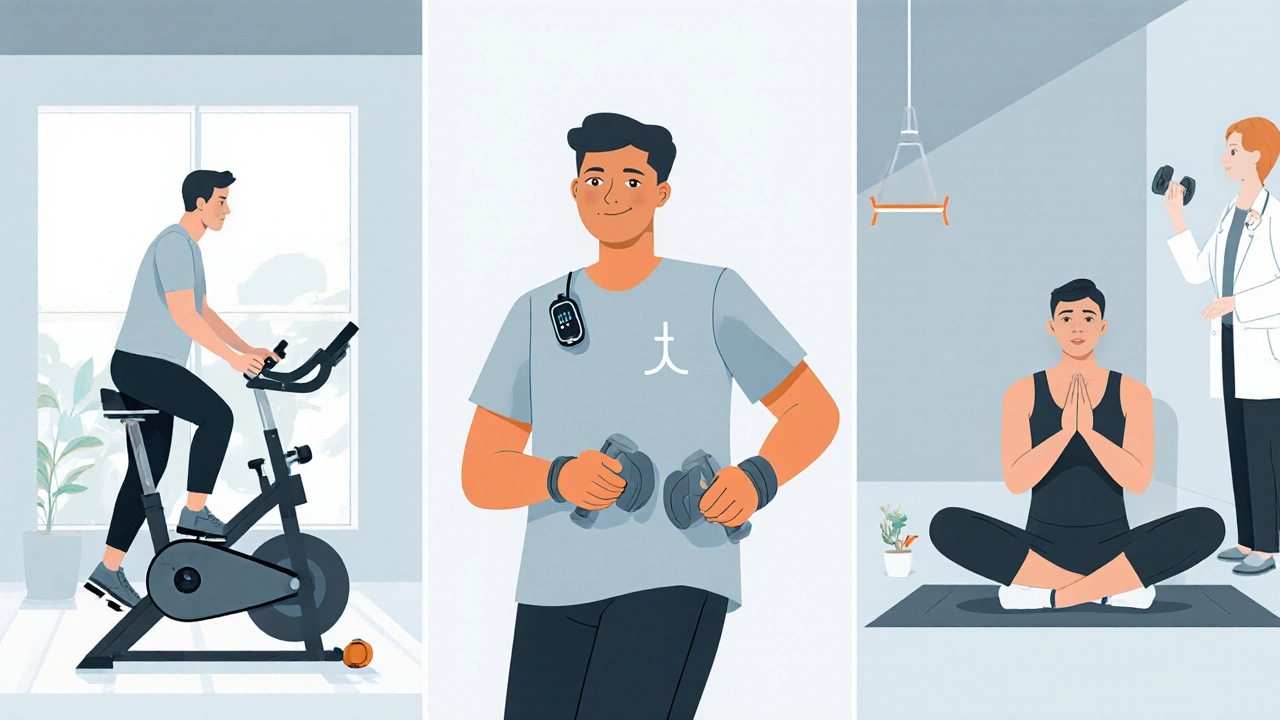COPD Exercise Intensity Checker
Check Your Exercise Intensity
Use the "talk test" recommended in COPD guidelines to ensure your exercise is safe and effective.
Living with chronic obstructive pulmonary disease (COPD) can feel like you’re constantly out of breath, especially when everyday tasks turn into mini‑marathons. The good news? Adding the right kind of exercise to your routine can slow the disease’s progression, lessen flare‑ups, and boost quality of life. Below we break down exactly why movement matters, which activities are safest, and how to build a plan that works for your lungs and your schedule.
Quick Takeaways
- Regular aerobic activity improves lung capacity and reduces breathlessness.
- Strength training helps the muscles that support breathing, making each inhalation easier.
- Pulmonary rehabilitation programs combine supervised exercise with education for the best results.
- Start low, go slow: the 10‑minute walk rule keeps you safe while you build stamina.
- Track progress with spirometry or a simple symptom diary to see real improvements.
Understanding COPD
When we talk about COPD, we refer to a group of progressive lung disorders that block airflow and make breathing difficult. It includes emphysema, chronic bronchitis, and sometimes refractory asthma. According to the Global Initiative for Chronic Obstructive Lung Disease (GOLD), over 250million people worldwide live with COPD, and the condition is the third leading cause of death globally.
COPD is a chronic, progressive lung disease characterized by airflow limitation that is not fully reversible. It typically results from long‑term exposure to irritants such as tobacco smoke, occupational dust, or air pollution. Common symptoms include chronic cough, sputum production, and increasingly severe dyspnea during activity.
Why Exercise Matters for COPD
Exercise isn’t just about burning calories; it triggers a cascade of physiological changes that directly counteract COPD’s effects. Here’s how:
- Improved Ventilatory Efficiency: Regular aerobic work enhances the coordination between the heart and lungs, allowing you to take in more oxygen with each breath.
- Reduced Inflammation: Studies published in the European Respiratory Journal show that a 12‑week walking program can lower systemic inflammatory markers like CRP by up to 15%.
- Strengthened Respiratory Muscles: Targeted strength training adds bulk to the diaphragm and intercostal muscles, reducing the effort needed to inhale.
- Better Oxygen Utilization: Exercise trains peripheral muscles to use oxygen more efficiently, meaning you need less from your lungs during daily tasks.
All these benefits translate into fewer exacerbations, decreased hospital admissions, and a noticeable boost in daily energy levels.

Types of Exercise That Work for COPD
Not all movement is created equal. Below is a quick‑look table that matches exercise type with its primary benefit and a few practical tips.
| Exercise Type | Primary Benefit | Practical Tips |
|---|---|---|
| Aerobic (walking, stationary cycling) | Improves oxygen uptake, reduces dyspnea | Start with 5‑10min, 3×/week; increase by 5min every two weeks |
| Resistance (light weights, resistance bands) | Strengthens skeletal and respiratory muscles | 2 sets of 10‑12 reps, 2×/week; use 1‑2kg dumbbells |
| Breathing (pursed‑lip, diaphragmatic) | Enhances ventilation efficiency | 5‑minute sessions before/after aerobic work |
| Flexibility (gentle yoga, stretching) | Improves thoracic mobility, reduces stiffness | Hold each stretch 20‑30sec, 3×/week |
Choosing a mix of these activities maximizes overall lung health. If you’re unsure where to start, a pulmonary rehabilitation program can tailor a schedule for you.
Designing a Safe Exercise Plan
Before lacing up your sneakers, a quick assessment is critical. Talk to your pulmonologist about your latest spirometry results, especially your FEV1 (forced expiratory volume in one second). Values above 50% of predicted are generally safe for moderate activity, while lower numbers may need a supervised setting.
- Set Realistic Goals: Aim for a total of 30minutes of moderate activity per week, split into manageable chunks.
- Choose the Right Intensity: Use the “talk test.” If you can speak a full sentence without gasping, you’re in the right zone.
- Schedule Sessions: Consistency beats intensity. Pick the same days each week-e.g., Monday, Wednesday, Friday.
- Warm‑up & Cool‑down: Ten minutes of gentle walking or arm swings prepares the lungs and prevents sudden breathlessness.
- Monitor Symptoms: Keep a simple log of heart rate, oxygen saturation (if you have a pulse oximeter), and perceived exertion on a 0‑10 scale.
- Adjust Medication Timing: If you use a short‑acting bronchodilator, take it 15 minutes before starting exercise.
Remember, the goal isn’t to push yourself to the limit; it’s to gradually expand what your lungs can handle without triggering an exacerbation.
Common Pitfalls & How to Avoid Them
Even well‑intentioned patients can slip into habits that undermine progress. Here’s a quick cheat‑sheet:
- Overexertion: Jumping from 5 to 30minutes in a single session can cause acute breathlessness. Stick to the 10‑minute rule and build up slowly.
- Ignoring Weather: Cold, dry air narrows airways. If you must exercise outdoors on a chilly day, wear a scarf over your mouth or use a heated mask.
- Skipping the Warm‑up: A sudden start can trigger bronchospasm. Always begin with low‑intensity movement.
- Not Using Supplemental Oxygen When Needed: If you’re prescribed portable oxygen, keep the device handy during walks.
- Skipping Follow‑up: Review your plan with a respiratory therapist every 3‑6 months to tweak intensity or add new exercises.

Tracking Progress and Seeing Results
Objective data helps keep motivation high. Two simple tools work well:
- Spirometry: Repeat tests every 6‑12 months. An increase of 100mL in FEV1 may not seem huge, but it often correlates with noticeable symptom relief.
- Symptom Diary: Record daily breathlessness on a 0‑10 scale, time spent walking, and any rescue inhaler use. Over weeks, you’ll spot patterns and celebrate improvements.
When you see fewer rescue inhaler puffs or a longer distance covered on the 6‑minute walk test, you know the exercise plan is paying off.
When to Seek Professional Help
If you notice any of the following, pause your routine and consult a healthcare provider:
- Sudden increase in cough or sputum production
- Chest pain or palpitations during activity
- Oxygen saturation consistently below 88%
- Persistent fatigue that doesn’t improve with rest
These signs could signal an exacerbation that needs medication adjustment or a brief rest period before resuming exercise.
Frequently Asked Questions
Can I start exercising without a formal pulmonary rehab program?
Yes. Begin with low‑intensity activities like a 5‑minute walk, and increase the duration gradually. However, a supervised program offers personalized guidance and faster progress.
How often should I do breathing exercises?
Aim for 5-10 minutes, twice daily. Pursed‑lip breathing before meals and diaphragmatic breathing after aerobic work are especially effective.
Is it safe to use a treadmill at the gym?
A treadmill is fine if you keep the incline low and start with short intervals. Keep a handheld oxygen cylinder nearby if you rely on supplemental O₂.
What’s the “talk test” and how do I use it?
During activity, try speaking a full sentence. If you can finish it without gasping, you’re in a moderate‑intensity zone. If you’re breathless after a few words, dial back the effort.
Do I need a heart‑rate monitor for COPD exercise?
It’s helpful but not mandatory. Aim for 60-80% of your age‑predicted maximum heart rate; a simple fitness tracker can give you that range.
Incorporating regular, targeted exercise into your COPD management plan isn’t a luxury-it’s a core component that can slow disease progression, reduce medication dependence, and restore the joy of simple activities like climbing stairs or gardening. Start small, stay consistent, and let each step bring you closer to easier breathing.


Claire Kondash
When we contemplate the delicate dance between breath and movement, one cannot help but marvel at the paradox that exercise, an act that temporarily taxes the lungs, ultimately becomes a balm for chronic obstructive pulmonary disease 🌬️. The article beautifully outlines how the incremental stress placed on respiratory muscles triggers adaptive remodeling, akin to the way a sculptor refines marble with each gentle tap. Yet, the true wisdom lies in the humility of starting small-just a five‑minute stroll, a whispered promise to the body that we will not be overwhelmed. Over weeks, that modest walk expands, not merely in distance but in the confidence it imparts, reshaping neural pathways that govern perception of dyspnea. The “talk test” emerges as a simple yet profound gauge, reminding us that communication, even with our own lungs, is a two‑way street; if speech flows without gasp, we are within safe limits. Moreover, the integration of resistance training fortifies the diaphragm, turning a once‑fragile muscle into a resilient pillar of ventilation. Flexibility work, often dismissed, actually unlocks thoracic mobility, allowing the rib cage to expand with less effort. The article’s emphasis on pulmonary rehabilitation reflects a broader truth: supervised, multidisciplinary guidance accelerates progress and mitigates risk, much like a seasoned captain navigating stormy seas. By tracking spirometry and symptom diaries, patients gain tangible evidence of improvement, transforming abstract hope into measurable milestones. It is also worth noting that systemic inflammation, a silent adversary in COPD, can be attenuated through consistent aerobic activity, a fact supported by recent European Respiratory Journal studies. The cascading benefits-enhanced oxygen utilization, reduced exacerbations, and improved quality of life-culminate in a narrative that transcends medicine, touching the very essence of human resilience. As we embrace each step, each breath, we participate in a quiet rebellion against the notion that chronic disease must dictate a life of limitation. 🌟 In this light, exercise is not merely a therapeutic adjunct; it is an act of empowerment, a declaration that we retain agency over our bodies.